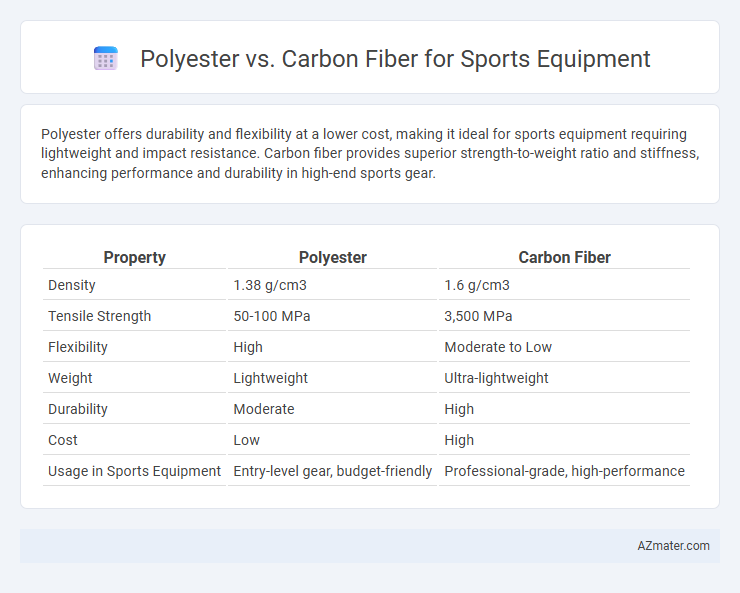Polyester offers durability and flexibility at a lower cost, making it ideal for sports equipment requiring lightweight and impact resistance. Carbon fiber provides superior strength-to-weight ratio and stiffness, enhancing performance and durability in high-end sports gear.
Table of Comparison
| Property | Polyester | Carbon Fiber |
|---|---|---|
| Density | 1.38 g/cm3 | 1.6 g/cm3 |
| Tensile Strength | 50-100 MPa | 3,500 MPa |
| Flexibility | High | Moderate to Low |
| Weight | Lightweight | Ultra-lightweight |
| Durability | Moderate | High |
| Cost | Low | High |
| Usage in Sports Equipment | Entry-level gear, budget-friendly | Professional-grade, high-performance |
Introduction to Polyester and Carbon Fiber
Polyester is a durable synthetic polymer widely used in sports equipment for its flexibility, impact resistance, and cost-effectiveness. Carbon fiber, composed of thin strands of carbon atoms bonded together, is renowned for its exceptional strength-to-weight ratio and rigidity, making it a premium choice for high-performance sports gear. Both materials serve critical roles in optimizing durability and performance, with polyester favored for affordability and carbon fiber for lightweight strength.
Material Properties Comparison
Polyester fibers offer flexibility, low cost, and good impact resistance, making them suitable for sports equipment requiring durability and shock absorption. Carbon fiber features exceptional tensile strength, lightweight characteristics, and high stiffness, allowing for enhanced performance and precision in high-end sports gear such as tennis rackets and bicycle frames. The comparison highlights carbon fiber's superiority in strength-to-weight ratio, while polyester excels in elasticity and affordability for broader sports applications.
Durability and Strength Analysis
Carbon fiber exhibits superior strength-to-weight ratio and exceptional durability, making it ideal for high-performance sports equipment subjected to intense stress and impact. Polyester fibers, while more flexible and cost-effective, offer lower tensile strength and are prone to wear and fatigue over time, limiting their use in demanding athletic applications. The enhanced stiffness and resilience of carbon fiber ensure longer lifespan and optimal performance in sports gear such as tennis rackets, bicycles, and protective helmets.
Weight Differences Impact
Polyester fibers generally weigh more than carbon fibers, significantly affecting the overall weight of sports equipment. Carbon fiber's high strength-to-weight ratio allows for lighter, more durable gear, which enhances athlete performance by improving speed and reducing fatigue. The weight difference directly influences the agility and responsiveness of equipment such as bicycles, tennis rackets, and hockey sticks.
Flexibility and Performance
Polyester offers excellent flexibility and durability, making it suitable for sports equipment requiring moderate strength and elasticity, such as protective gear and apparel. Carbon fiber provides superior performance with high strength-to-weight ratio and exceptional stiffness, ideal for high-impact sports equipment like racing bicycles and tennis rackets. The choice between polyester and carbon fiber hinges on the balance between flexibility needs and performance demands in specific sports applications.
Cost Considerations
Polyester sports equipment offers a cost-effective option with lower manufacturing expenses and affordable raw materials, making it accessible for entry-level athletes. Carbon fiber, while significantly more expensive due to complex production processes and premium material costs, provides superior strength-to-weight ratio and durability. Budget constraints often dictate the choice, with polyester favored for economic efficiency and carbon fiber preferred for high-performance needs despite its higher price.
Manufacturing Processes
Polyester and carbon fiber differ significantly in their manufacturing processes for sports equipment. Polyester sports gear is produced using melt spinning, where polymer chips are melted and extruded into fibers, followed by weaving or knitting to create fabrics. Carbon fiber manufacturing involves carbonizing polyacrylonitrile (PAN) fibers at high temperatures in an inert atmosphere, resulting in lightweight, high-strength fibers that are then layered and cured with resin composites for enhanced performance and durability.
Environmental Impact
Polyester sports equipment relies on petroleum-based synthetic fibers that contribute to microplastic pollution and have a high carbon footprint during production. Carbon fiber, although energy-intensive to manufacture, offers greater durability and longevity, reducing the frequency of replacement and overall waste. Recycling methods for both materials remain limited, but advancements in carbon fiber reclamation show potential for minimizing environmental harm.
Popular Sports Equipment Examples
Polyester fibers are commonly used in sports apparel like jerseys and athletic wear due to their durability, moisture-wicking properties, and cost-effectiveness. Carbon fiber is popular in high-performance sports equipment such as tennis rackets, bicycle frames, and golf club shafts, offering superior strength-to-weight ratio and stiffness for enhanced performance. While polyester excels in flexibility and comfort, carbon fiber is favored for its lightweight rigidity and resilience in competitive sports gear.
Choosing the Right Material for Your Needs
Polyester offers durability and flexibility, making it ideal for affordable and versatile sports equipment like apparel and bags, while carbon fiber excels in lightweight strength and stiffness, perfect for high-performance gear such as bicycles and tennis rackets. Selecting the right material depends on balancing cost, weight, and performance demands specific to your sport and usage frequency. For competitive athletes seeking maximum efficiency, carbon fiber provides superior responsiveness, whereas casual users might prefer the comfort and affordability of polyester-based products.

Infographic: Polyester vs Carbon fiber for Sports equipment
 azmater.com
azmater.com